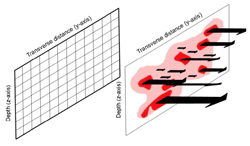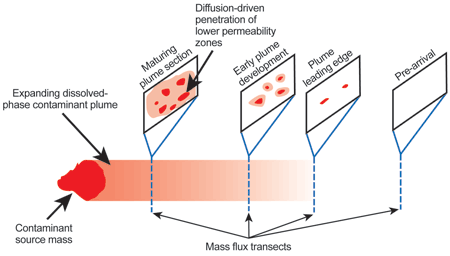Mass Flux
Overview
Most decisions regarding contaminated groundwater sites are driven by contaminant concentrations. These decisions can be improved by also considering contaminant mass discharge and mass flux. Mass discharge and flux estimates quantify source or plume strength at a given time and location. Consideration of the strength of a source or solute plume (i.e., the contaminant mass moving in the groundwater per unit of time) improves evaluation of natural attenuation and assessment of risks posed by contamination to downgradient receptors, such as supply wells or surface water bodies (ITRC 2010).
Mass discharge can also provide a meaningful way to identify contaminant trends and their implications, express average concentration reductions across the plume and, in some cases, support conclusions regarding treatment efficacy. Mass discharge measurements can provide a different perspective on the magnitude and average impact of site contamination, compared with traditional point measurements from monitoring wells (Kavanaugh et al. 2011).
In this discussion, mass flux is defined as the mass of a contaminant in the groundwater that passes through a predefined cross sectional area over a period of time. It can be used to calculate mass discharge, which is the total mass of a solute moving in the groundwater from a given source and is expressed in mass/time (ITRC 2010). Contaminant movement through the subsurface is highly variable.
Guilbeault et al. (2005) examined three sites with sandy aquifers and found that three-quarters of the discharge occurred in 5 to 15 percent of the plume cross-sectional area. Contaminant concentrations at these sites varied as much as four orders of magnitude across 30-cm vertical intervals.
On the other hand, concentrations and gradient may be the same, but as illustrated in Figure 2, the hydraulic conductivity of a given unit can cause the flux and mass discharge to be considerably different.
A review of case studies in which mass discharge and mass flux metrics were used indicates the potential for their application to a variety of remediation management objectives (ITRC 2010):
- Site characterization and conceptual site model development.
- Potential impacts and exposure evaluation.
- Remedy selection and design.
- Performance monitoring, evaluation, and optimization.
- Compliance monitoring.
- Site prioritization.
References:
Benefits of Partial DNAPL Source Removal: Measuring Contaminant Flux Change
M.D.Annable, K. Hatfield, J. Cho, M.C. Brooks, A.L. Wood, C.G. Enfield, C. Holbert, and K. Gorder.
The Fifth International Conference on Remediation of Chlorinated and Recalcitrant Compounds, (Monterey, CA; May 2006): Book of Abstracts. Battelle Press, Columbus, OH. Poster presentation, 2006.
At Hill AFB, two innovative methods for measuring water and contaminant mass flux at a DNAPL site were evaluated after the implementation of surfactant flushing. Ten monitoring wells on ~10-ft centers were placed downgradient from the DNAPL source zone. In one technique, a transect of passive flux meters (PFMs) was used to measure TCE mass flux passing through the PFMs before and after the surfactant flood. The meters indicated a reduction in TCE flux of approximately 90%. With the other technique—the integral pumping test method—water was subsequently extracted from the same series of wells, and contaminant concentration/time series was measured in each pumping well effluent. These methods were also compared to mass flux calculated using water quality data from the transect of fully screened wells. The three independent measurement techniques provided comparable results, showing significant contaminant mass flux reduction following remediation.
![]() Diagnostic Tools for Performance Evaluation of Innovative In-Situ Remediation Technologies at Chlorinated Solvent-Contaminated Sites. Final Report: Watervliet Arsenal
Diagnostic Tools for Performance Evaluation of Innovative In-Situ Remediation Technologies at Chlorinated Solvent-Contaminated Sites. Final Report: Watervliet Arsenal
M. Kavanaugh, R. Deeb, and E. Hawley.
ESTCP Project ER-200318, 275 pp, 2011.
Flux-Based Criteria for Management of Groundwater
CRC for Contamination Assessment and Remediation of the Environment, Adelaide , Australia : CRC CARE Technical Report 31, ISBN: 978-1-921431-43-2, 71 pp, 2014
This report reviews guidance, documents, tools, and industry practice relating to the application of mass flux-based criteria for the management of groundwater contamination. It attempts to define where further work should be carried out to realize the advantages of mass flux-based assessment of groundwater contamination and to identify the most reliable and promising methods for further research and application. Although the focus of this report is on Australian regulations and practice, its findings and recommendations can be expected to have general applicability. The focus here is on mass flux and mass discharge associated with groundwater contamination in the dissolved phase; only brief consideration is given to the use of mass flux relative to free-phase transport.
Measurement and Use of Mass Discharge and Mass Flux at Contaminated Sites
SERDP-ESTCP On-Demand Video, 03:12:37 min + 153 slides, 2010
This short course is based on the ITRC (2010) technology overview document, Use and Measurement of Mass Flux and Mass Discharge. The presenters describe available measurement and estimation techniques and examine several case studies of mass flux measurements at contaminated sites. The course has six modules.
![]() Review of Groundwater Contaminant Mass Flux Measurement
Review of Groundwater Contaminant Mass Flux Measurement
M.N. Goltz, S. Kim, H. Yoon, and J. Park.
Environmental Engineering Research 12(4):176-193(2007).
Archived CLU-IN Seminars:
- ITRC: Use and Measurement of Mass Flux and Mass Discharge
ITRC, Archive of Sep 28, 2017 Seminar (2 Hours, 15 Minutes) - Characterizing Mass Transfer and Mass Flux for DNAPL Source Zones
Archive of Jan 22, 2008 Seminar (1 Hour, 30 Minutes) - Characterizing Mass Transfer and Mass Flux for DNAPL Source Zones
Archive of Feb 5, 2008 Seminar (1 Hour, 30 Minutes) - DNAPLS - Source Zone Behavior and Mass Flux Measurement
Archive of Aug 10, 2005 Seminar (2 Hours) - Using High-resolution Piezocone to Determine Hydraulic Parameters and Mass Flux Distribution
Archive of Aug 27, 2008 Seminar (1 Hour, 30 Minutes)







